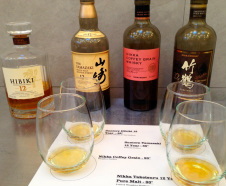 If your only vision of Japanese whisky involves Bill Murray drinking Suntory, it is not your fault. The range of Japanese whiskies available in the US has been limited and expensive. But in the last couple of years, Japanese whisky’s popularity—and thankfully, availability—has soared, allowing in some younger and more affordable whiskies. Japanese whisky traditionally follows in the Scotch tradition, but with its own distinct flavor absorbed from the Japanese environment. To learn more, I spent a Saturday afternoon at Char No. 4 at a Japanese tasting class led by their whiskey expert, Allan Roth.  Whisky in Japan is generally sourced to Masataka Taketsuru, who was sent to Scotland in 1918 to study chemistry and Scotch-making. He brought his expertise— and Scottish wife—back to Japan, where he was distiller at Japan’s first distillery to make just whisky, founded by Shinjiro Torii. Shinjiro went on to found Suntory and Masataka founded Nikka, the two brands that lay the foundation for the fine art of Japanese whisky-making. We started with Suntory’s Hibiki 12, a charming blend that is light and gentle. In Japan, blended whiskies are commonly drunk as highballs with water and ice. It dilutes the whiskey flavor, but also pulls out the individual flavors more, making it easier to detect flaws in the taste. Consequently, they are balanced and approachable – even without the water. We next tried Suntory’s Yamazaki 12-year, which takes from whiskey aged in three different types of casks – bourbon, sherry, and mizunara (Japanese Oak), a slow maturing cask that imparts traditionally eastern notes, such as sandalwood and incense. This was the first Japanese single malt available in the US—in 1984—and remained the only one for many years, establishing a nice reputation for Japanese whisky. Our next whisky was Nikka’s Coffey Grain from the Miyagikyo Distillery, which makes a single grain whisky using 19th century Coffey Stills imported from Glasgow. Most places have switched to the more modern column stills because of the inefficiencies of the older Coffey stills, but for those willing to use them, Coffey stills lend a flavorful character. This whisky is mainly corn, aged in new charred oak barrels, which gives it more traditional American whiskey notes, such as chocolate, banana, and that corn sweetness, but still with an original flavor all its own. Our final whisky was a Nikka’s Taketsuru 12-year, which draws from two distinctly different distilleries. The distillery in Myagikyo is from the 1960’s and, in addition to the two Coffey stills, has other more modern stills, which produce lighter summer fruit flavors. By contrast, the distillery in Yoichi is more traditional and uses coal-fired stills and peat to produce richer, heavier, smokier flavors. The result is an interesting blend of florals and fruit along with spice and oak. Fun fact: the name Nikka is a shortened version of the name of a juice company Taketsuru founded—Dai Nippon Kaju—where he originally produced apple juice while waiting for his first whiskies to mature. Whisky is certainly my Japanese juice of choice. Comments are closed.
|
Archives
November 2017
|

 RSS Feed
RSS Feed
